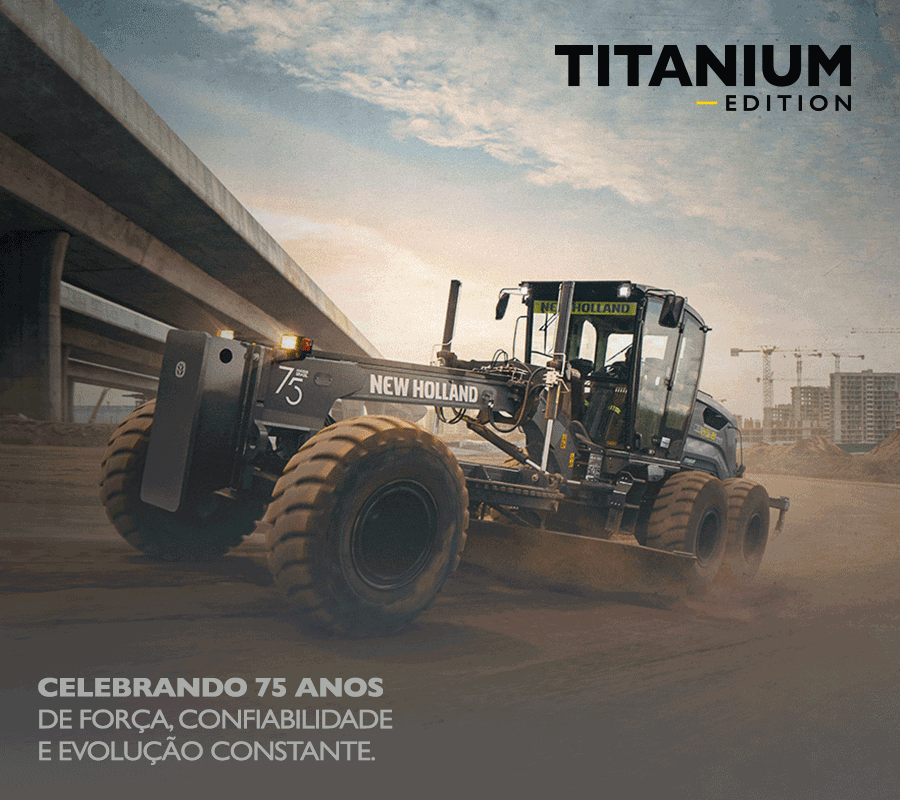The boom in the market for booms
 With record consumption of aerial work platforms in 2011, the market is preparing to meet growth in demand with specific models for each application
With record consumption of aerial work platforms in 2011, the market is preparing to meet growth in demand with specific models for each application
In 2011, the Brazilian market for aerial work platforms (AWPs), which is served almost exclusively by equipment rental companies, reached a record rate of growth which has been causing an impact on the business. According to rental companies interviewed by M&T magazine, the market has consumed some 5,000 aerial work platforms - a significant number considering that the fleet of such equipment in activity in the country is estimated to be around 10,000 units.
If this expansion reflects growth in demand for this equipment, it has also wound up causing certain side effects such as cannibalization of rental prices and a shortage of replacement parts and skilled labor. Industry specialists point out that these problems are a reflection of unbridled expansion in demand. "What is happening in the Brazilian market for aerial work platforms is very similar to what occurred in the U.S. market in the past when the annual growth rate remained at an average of 35% for several years," says Sergio Kariya, director at Mills Rental.
The executive’s comparison refers to the past four years of operation in the Brazilian market (2007-2011) when the sector grew on average 38% annually, increasing the fleet from 3,000 units in 2006 to 15,000 units by the end of 2011. “The difference is that the United States presently has a fleet of 680,000 units of this equipment, which allows us to predict that Brazil has a long way to go and that growth rates must remain between 35% and 40% for the next several years for us to reach the same level,” adds Kariya.
In the assessment of Paulo Esteves, director of rental company Solaris, year 2011 was marked by a large volume of investment, both by rental companies that were financially sound and well structured and by unprepared startups, as well. The latter, in his view, provoked a cannibalization of rental prices reducing the profitability of the industry. “Therefore, I believe that in 2012 investments will be smaller, allowing us to improve on the profitability of the rental business.” He believes that this does not mean an increase in rental prices. “On the contrary, they should drop even further, but since there will be less need for investment, rental companies can better equalize their profitability.”
A promising future
Responsible for over 90% of the aerial work platforms and telehandlers used in, equipment rental companies are adapting to the new reality. According to Ricardo Dias, general manager of Orguel Platforms, rental prices dropped about 30% between 2008 and the first half of 2011. “From the second half of last year on, there has been a slight recovery in prices, but nothing compared to what they were in early 2008,” he assesses.
Weaker sales in the market is not quite what executive Yuri Caldeira, director of Locar for the areas of platforms, telehandlers and cranes, expects for 2012. He bases his projections on a meeting held among the ten largest equipment rental companies in Brazil at the headquarters of one of the leading manufacturers in the sector where they carried out a sort of ‘blinded’ projection of consumption.
At this meeting, each rental company executive wrote down on plain, unmarked paper how many platforms and handlers they intended to buy in 2012. The outcome, considering only the figures for these leading companies, was a sales projection of 4,000 units. “Actually, I have information that manufacturers expect to sell another 5,000 aerial work platforms in 2012, but they know they will have a reduction in sales of handlers,” he reveals.
Right-sizing of the fleet
When it comes to expanding a fleet, Locar has practical experience of its own. After all, the company started operating in the rental of this type of equipment just two years ago and already has a population of about 1,000 aerial platforms and 300 handlers. This, according to Caldeira, places Locar third among the three largest companies in the sector; behind Solaris - whose fleet of handlers and platforms consists of around 2,000 units, and Mills Rental - which does not disclose the size of the fleet for strategic reasons since it is the only one among these companies which is publicly traded.
To Yuri Caldeira, a well-sized rental fleet must show care not only in the quantity of equipment, but also in the variety of models. “We evaluated that a basic rental fleet must have at least 15 different models, including pantograph or scissor-type, articulated (knuckle-boom) and telescopic-boom platforms.” Within these three categories, the specialist at Locar, as well as the others whom we interviewed, provided details on the most suitable models for each type of need.
In the case of scissor lifts, for instance, Paulo Esteves of Solaris states that the most popular are the ones with electric drives and which reach working heights of 6, 8 and 10 meters. “The scissor-type models with electric drives represent 90% of the demand and are used mainly in performing indoor work,” he says. Diesel powered models, though, are mostly used in outdoor applications - such as in the restoration of façades, installation of metal structures and periodic maintenance of buildings. These machines have tables/supports that enable perpendicular operation; a characteristic of scissor lifts.
The predominance of electric drive scissor platforms, to Sergio Kariya of Mills Rental, is also due to the lower cost involved in acquiring, operating and maintaining these models in comparison to diesel-powered equipment. “Even so, in our assessment diesel models will be more popular because they enable working outdoors and on surfaces of land that are less level than those found in manufacturing environments or logistics warehouses where most of the scissor-type models in activity operate,” he assesses.
To the list of the most popular scissor-type lifts, Yuri Caldeira of Locar adds models that extend to 12 m in height for indoor work. “Because our rentals cater considerably to the infrastructure sector, these lifts that afford greater working heights find applications in services such as the construction and maintenance of toll plazas, work on the façades and piers of airports, besides their traditional places of operation in industrial warehouses,” he says.
Ricardo Dias of Orguel shares in Caldeira’s assessment pointing out that the most popular scissor lifts are those with working heights between 10 m and 12 m. “Although diesel powered models can move over more irregular terrain, the lifting operation still requires equipment to be brought to rest on a level surface, which sometimes requires preparation of the surface in advance.” The gases produced by combustion, he says, also weigh against the choice of diesel models for operations indoors.
Preference at construction sites
At construction sites, where the use of aerial work platforms became popular after changes in the NR-18 standard - with more restrictive articles reading safety in the elevation of personnel assigned to work at great heights, the preference is for models equipped extensions known as ‘booms’. Among these models, the number of diesel-powered AWPs is higher than those with electric drives, but both models are appropriate for situations where both vertical and horizontal reach is required. “The most requested range of booms are those with 15 m in height”, says Yuri Caldeira.
Paulo Esteves of Solaris explains that models with heights of 14, 19 and 25 m lead in demand for use in industrial assembly works, general civil construction, expansions of industries, construction of stadiums and offshore oil platforms. “Basically, they are only rarely used in residential construction,” he analyzes. “In models above 19 m, practically all the platforms are diesel powered, while for platforms in a lower range of heights, up to 15 m, the proportion is 70% diesel and 30% electric drive.”
Despite the greater popularization of smaller models, Esteves says that the Solaris fleet consists of booms with up to 43 m in height, used in large projects such as seaport complexes and soccer stadiums. “When it comes to aerial platforms above 30 m working height, we are essentially dealing with telescopic boom models.” For equipment with a shorter reach, he explains that there are aerial platforms with telescopic as well as articulated or ‘knuckle’ booms which are typically utilized more often at Brazil’s construction sites.
Articulated vs. Telescopic
The Solaris executive explains that user preference for knuckle booms is a matter of local culture, seen only in Brazil, where opinions are that that this configuration allows the machine to reach places of difficult access. However, Esteves states that there is no technical basis for this argument.
“In the United States, for example, most of the equipment in use is equipped with telescopic booms for the simple reason that this configuration makes the platform more affordable and easier to operate.” In addition, the executive says that these models require less maintenance and can also perform most of the services assigned to articulated-boom aerial work platforms.
According to Esteves, rental companies made an error of assessment during the phase of promotion of such equipment in Brazil, when they prioritized the offer of articulated-boom work platforms to the detriment of telescopic platforms. This strategy is said to have led to a feeling among customers that knuckle-boom models have a wider range of applications. Sergio Kariya of Mills Rental explains that aerial work platforms with articulated booms are recommended for situations in which one must overcome obstacles in the middle of the way. “There are double-jointed models which you are able to configure to overcome two obstacles, which makes the boom look like a letter ‘Z’,” he says
Among the types of aerial work platforms available in Brazil, there are also some special models which use crawlers instead of wheels. “There are manufacturers that offer machines with tractor tracks on either side, like in excavators, and others who choose to adopt individual crawler belts that act like tires," says Mills Rental executive Kariya.
According to Kariya, both models are recommended for very severe operations where traditional 4x4 (four-wheel drive) aerial work platforms cannot move about. “Presently, we have two such units rented out for the construction of a pharmaceutical company in the South region of the country,” says Sergio Kariya. According to him, the company has already rented such equipment for the installation of tanks for Petrobras upon sandy ground, which barred the use of equipment on tires.
Shortage of manpower
Besides specifying the right equipment for the desired application, experts are unanimous in reporting the need for skilled, qualified personnel for the operation of aerial work platforms. They also share the view that manufacturers of these machines have a long way to go regarding after-sales service, especially in providing parts for immediate delivery.
“Proof of this is that we maintain an internal inventory of US$ 5 million in spare parts to support our operations and buyers of second-hand machines to whom we sell those assets after four or five years of use,” reveals Paulo Esteves of Solaris.
As regards manpower, rental companies have formatted training programs to help meet the needs of the market. Mills Rental, for example, joined IPAF (the International Powered Access Federation) through which it has accredited seven training centers in Brazil. “Trained operators receive IPAF accreditation which qualifies and enables them to work in any of the 80 countries in which the institution operates,” says Kariya. “With this initiative, we are competing among the top four training centers accredited by IPAF. This demonstrates that the drive to qualify Brazilian AWP operators is on the right track,” he concludes.

Av. Francisco Matarazzo, 404 Cj. 701/703 Água Branca - CEP 05001-000 São Paulo/SP
Telefone (11) 3662-4159
© Sobratema. A reprodução do conteúdo total ou parcial é autorizada, desde que citada a fonte. Política de privacidade












